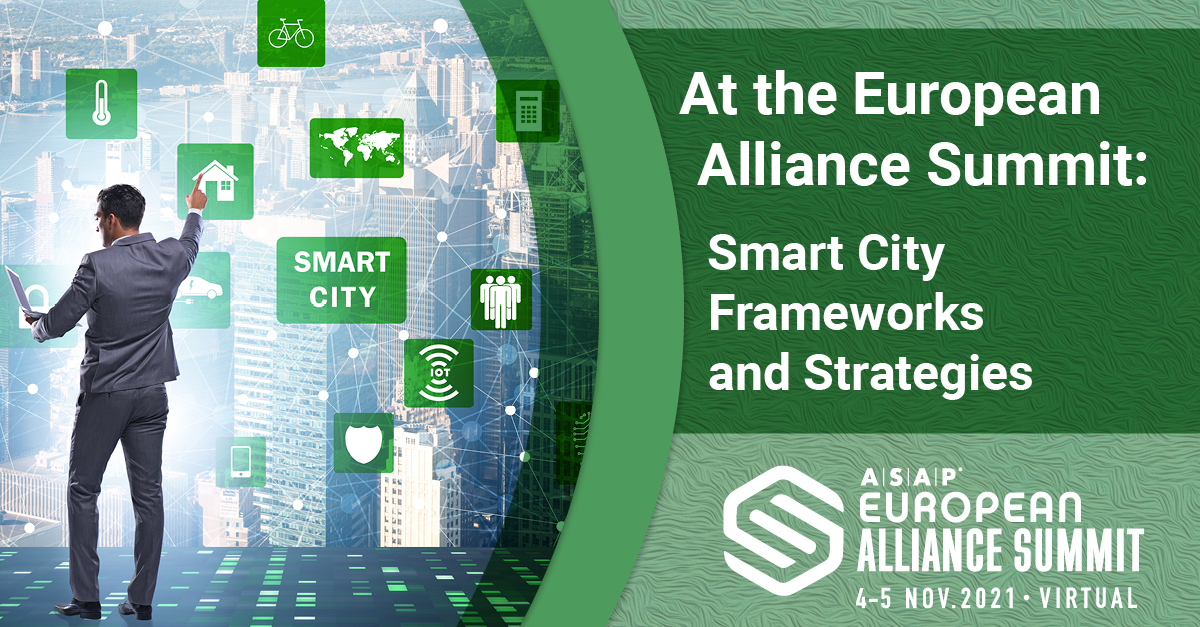An Intelligent Framework for a Smart City
Many tech companies are hard at work trying to digitize urban environments and create smart cities. The eco-friendly smart city vision is an all-encompassing one. It entails an increased reliance on public transportation using vehicles that run on renewable energy sources. It calls for products and services delivered by public and private entities to be similarly fueled by sustainable forms of power via smart grids.
Jacques Vermeulen, director of smart cities at Nokia, gave attendees of the 2021 ASAP European Alliance Summit a glimpse of the complex web of technologies that underpins such a digital metropolis—one that includes sensor-laden internet-connected devices, cloud platforms, networks, machine learning (ML) and artificial intelligence (AI) analytics algorithms, and cybersecurity solutions, among many other components—in his presentation “Smart City Ecosystem Frameworks and Strategies.”
Relying on Digital Services and Public Transportation, Not Cars
A successful smart city starts with the democratization of broadband access. If everyone in town enjoyed seamless, high-speed internet access on devices of their choice, then there would theoretically be more reliance on telehealth, videoconference- and internet-based government interaction, e-finance solutions, distance learning, remote work, and other electronic services. As a slide from Vermeulen’s presentation deck summarized, “Their widespread usage can significantly reduce the need for transport.”
The remaining necessary trips outdoors ideally should be made via public transportation to reduce the increasing traffic congestion caused by millions of individual automobiles. Not only do city transportation authorities need clean-energy vehicles, they also require connectivity in all pieces of the supporting infrastructure. Bus stops, public street lamps, bench manufacturers, garbage-can producers, and other equipment manufacturers must “deploy IoT sensors and connectivity” and “intelligently share data in an individualized manner,” according to Vermeulen. That is, all stakeholders, whether it be a startup, a government agency, or established private entity, can access data from these devices.
For example, cities instituting low-emissions vehicle zones—an increasingly common occurrence in Europe—can implement plate-recognition capabilities using security cameras to ensure registered vehicles meet these standards, while companies can monetize the video feeds within the boundaries of the EU’s General Data Protection Regulation (GDPR) and other applicable privacy statutes.
Come Together, Right Now, over Design
This public-private, cross-sector collaboration is still a new phenomenon. Where these aforementioned manufacturers were siloed before, they now “come together in design” more often to assess what works for citizens and customers and what doesn’t, said Vermeulen.
Beyond these players, Vermeulen noted that “human scientists” from the world of academia would also have to play a part in determining how data-driven services and infrastructure should be incorporated into society’s quotidian rhythms and guide “the evolution of our socio-economic environment.”
Nokia Driving the Driverless Bus
Nokia is driving initiatives in its own backyard to boost public transportation and discourage individual vehicle ownership. In the city of Espoo, Finland, it is working with a consortium of 25 other organizations to power an autonomous shuttle bus. It is combining its 5G network, private wireless offerings, and other mobile services with the products of AI and ML platforms, bus manufacturers, sensor makers, and others to share data that ensures vehicles stay on their route and passengers have up-to-the-second schedule information.
“Working [toward] green mobility drives ecosystem collaboration,” said Vermeulen.
Coming Straight from the Underground
For those still eschewing public transportation, electric vehicle charging stations would be housed underground to clear room on the sidewalks of increasingly densely populated urban centers. In fact, Vermeulen showed photos of a station of this type and explained how consumers could fill up under LED lights charged by renewable energy sources 24/7—another example of how “different stakeholders from different siloes are coming together again.” If cities were to extend the smart city vision, data could be sent to energy companies while the driver is charging up the vehicle to detect patterns in how, when, and where power is flowing to vehicles, so that supply could be adjusted to meet consumption needs.
“If we’re looking to green energy, we need to start rethinking our local grid demand-response balancing,” said Vermeulen.
2021 ASAP European Alliance Summit registrants can rewatch “Smart City Ecosystem Frameworks and Strategies” in the conference portal and see all of the elements of Vermeulen’s vision. View it today and hear about how Nokia has overcome barriers created by various government regulations, including GDPR; the importance of having at least one stakeholder accountable for the ecosystem’s entire operation and results; striking the balance between the needs of society and the individual; and how to deal with intellectual property concerns between the ecosystem participants.

